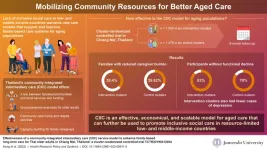“Our results show the importance of sustainable, long-lasting, physical activity programs set in schools for children’s health at both the individual and the population level. While this study analysed only the effectiveness of such program for obesity prevention, physical activity programs are likely to benefit growth and development, improve fitness, enhance mental health and boost cognitive performance of the children, and should be a cornerstone of educational and health policies,” said Maroje Sorić, MD, PhD, University of Zagreb in Croatia. Sorić is one of the study’s senior authors.
Although the beneficial health effects of initiating physical activity intervention programs during childhood are well documented, most of this evidence comes from short-term efficacy trials conducted in well-controlled settings, usually without implementing large-scale or scalable population-based approaches. Experts explain the current lack of successfully implemented school-based physical activity interventions in real-world settings impedes the fight against childhood obesity. The present study leverages a natural experiment that provided the opportunity to examine the effectiveness of Healthy Lifestyle, a real-world, population-based, longitudinal physical activity intervention on body mass index (BMI) in children aged 6-to-14 years. The intervention is derived from a previous and successful small-scale physical activity intervention in individual Slovenian schools.
Between 2011–2018, Healthy Lifestyle was a nationwide intervention introduced in 216 Slovenian schools with more than 34,000 participants compared with the same number of schools and non-participants. Generalized estimating equations were used to estimate the effects of differing levels of exposure to the intervention (i.e., from 1-5 years) on BMI in children with normal weight, overweight or obesity at baseline.
The intervention provided two additional physical education lessons in first through six grades and three additional lessons in seventh to ninth grades. The additional lessons were not part of the required curricula but were organized to take place immediately after regular school hours. Once children obtained written parental consent, their participation was compulsory. The intervention was offered to all children in an individual school and organized as an elective course. The maximum number of children per class was between 16–30.
Physical education specialist teachers associated with the program were required to provide at least 12 different sports per triennium, and had to prioritize the three most established sports in the local environment. The teachers also had to provide information on healthy dietary and lifestyle habits regarding energy balance, limiting the consumption of snacks and sugar-sweetened beverages and promoting a diverse diet.
The intervention was designed through a bottoms-up approach, meaning that schools were totally independent in selecting the contents and form of work. The parents of participants did not receive any educational materials nor were they involved in the intervention in any way.
Results revealed that BMI was lower in the intervention group, irrespective of participation duration or baseline weight status. The difference in BMI increased with the program duration, with maximal effects seen after three-to-four years of participation, and was consistently larger for children with obesity, peaking at 1.4 kg/m2 for girls with obesity and peaking at 0.9 kg/m2 for boys with obesity. The program started to become effective at reversing obesity after three years, whereas the lowest numbers needed to treat were observed after five years.
“The analysed outcomes of our intervention confirmed that introducing two-to-three additional education lessons per week to reach one hour per day can provide children with enough high-intensity physical activity to re-balance energy consumption and expenditure, and reverse numerous cases of obesity in school settings. Since all the contents of the intervention were planned and implemented by physical education specialist teachers, our case emphasises the importance of not only sufficient quantity but also of sufficient quality of organized physical activity of higher intensity that provides strong enough impulse to trigger positive transformative processes in body composition and beyond,” said study senior author Gregor Starc, PhD, University of Ljubljana in Slovenia.
“This study demonstrates that small changes to physical activity programming in schools can, given enough time, make a significant difference in health outcomes, including obesity. This study speaks to two well-known facets of successful health-related programs. The first is that structural components of an individual’s environment, such as additional physical activity classes, can significantly influence health outcomes. The second is that long-term consistency plays a key role in weight-related outcomes. This study’s outcomes open the discussion around the need to consider other small incremental changes that could be made to children’s environment, such as diet or marketing, and the need to measure these changes under real-world conditions over a long-sustained period of time,” said Travis Masterson, PhD, Broadhurst Career Development Professor for the Study of Health Promotion and Disease Prevention, The Pennsylvania State University. Masterson was not associated with the research study.
The study, titled “Effectiveness of a Population-scaled, School-based Physical Activity Intervention for the Prevention of Childhood Obesity” will be published in the March 2023 print edition of Obesity.
Other study authors include Gregor Jurak and Shawnda A. Morrison, University of Ljubljana in Slovenia. Petra Jurić, University of Zagreb in Croatia, is the corresponding author.
These analyses were conducted within the STOP project, funded by the European Commission’s Horizon 2020 research and innovation program under Grant Agreement No. 774548. The content of this document reflects only the authors’ views, and the European Commission is not liable for any use that may be made of the information it contains. Limited non-specific funding was provided also by the Slovenian National Research Agency program P5-0142 Bio-psycho- social context of kinesiology. Jurić’s work was funded by the Croatian Science Foundation, Grant Number DOK-2018-09-8532.
The authors declared no conflicts of interest.
# # #
The Obesity Society (TOS) is the leading organization of scientists and health professionals devoted to understanding and reversing the epidemic of obesity and its adverse health, economic and societal effects. Combining the perspective of researchers, clinicians, policymakers and patients, TOS promotes innovative research, education and evidence-based clinical care to improve the health and well-being of all people with obesity. For more information, visit www.obesity.org.
END


